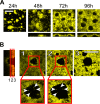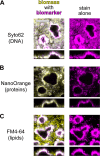Quorum Sensing Influences Burkholderia thailandensis Biofilm Development and Matrix Production
- PMID: 27068594
- PMCID: PMC5019063
- DOI: 10.1128/JB.00047-16
Quorum Sensing Influences Burkholderia thailandensis Biofilm Development and Matrix Production
Abstract
Members of the genus Burkholderia are known to be adept at biofilm formation, which presumably assists in the survival of these organisms in the environment and the host. Biofilm formation has been linked to quorum sensing (QS) in several bacterial species. In this study, we characterized Burkholderia thailandensis biofilm development under flow conditions and sought to determine whether QS contributes to this process. B. thailandensis biofilm formation exhibited an unusual pattern: the cells formed small aggregates and then proceeded to produce mature biofilms characterized by "dome" structures filled with biofilm matrix material. We showed that this process was dependent on QS. B. thailandensis has three acyl-homoserine lactone (AHL) QS systems (QS-1, QS-2, and QS-3). An AHL-negative strain produced biofilms consisting of cell aggregates but lacking the matrix-filled dome structures. This phenotype was rescued via exogenous addition of the three AHL signals. Of the three B. thailandensis QS systems, we show that QS-1 is required for proper biofilm development, since a btaR1 mutant, which is defective in QS-1 regulation, forms biofilms without these dome structures. Furthermore, our data show that the wild-type biofilm biomass, as well as the material inside the domes, stains with a fucose-binding lectin. The btaR1 mutant biofilms, however, are negative for fucose staining. This suggests that the QS-1 system regulates the production of a fucose-containing exopolysaccharide in wild-type biofilms. Finally, we present data showing that QS ability during biofilm development produces a biofilm that is resistant to dispersion under stress conditions.
Importance: The saprophyte Burkholderia thailandensis is a close relative of the pathogenic bacterium Burkholderia pseudomallei, the causative agent of melioidosis, which is contracted from its environmental reservoir. Since most bacteria in the environment reside in biofilms, B. thailandensis is an ideal model organism for investigating questions in Burkholderia physiology. In this study, we characterized B. thailandensis biofilm development and sought to determine if quorum sensing (QS) contributes to this process. Our work shows that B. thailandensis produces biofilms with unusual dome structures under flow conditions. Our findings suggest that these dome structures are filled with a QS-regulated, fucose-containing exopolysaccharide that may be involved in the resilience of B. thailandensis biofilms against changes in the nutritional environment.
Copyright © 2016, American Society for Microbiology. All Rights Reserved.
Figures





Similar articles
-
ScmR, a Global Regulator of Gene Expression, Quorum Sensing, pH Homeostasis, and Virulence in Burkholderia thailandensis.J Bacteriol. 2020 Jun 9;202(13):e00776-19. doi: 10.1128/JB.00776-19. Print 2020 Jun 9. J Bacteriol. 2020. PMID: 32312745 Free PMC article.
-
Two rsaM Homologues Encode Central Regulatory Elements Modulating Quorum Sensing in Burkholderia thailandensis.J Bacteriol. 2018 Jun 25;200(14):e00727-17. doi: 10.1128/JB.00727-17. Print 2018 Jul 15. J Bacteriol. 2018. PMID: 29507087 Free PMC article.
-
The Complex Quorum Sensing Circuitry of Burkholderia thailandensis Is Both Hierarchically and Homeostatically Organized.mBio. 2017 Dec 5;8(6):e01861-17. doi: 10.1128/mBio.01861-17. mBio. 2017. PMID: 29208745 Free PMC article.
-
Regulation of biofilm formation in Pseudomonas and Burkholderia species.Environ Microbiol. 2014 Jul;16(7):1961-81. doi: 10.1111/1462-2920.12448. Epub 2014 Mar 31. Environ Microbiol. 2014. PMID: 24592823 Review.
-
Quorum sensing in the genus Burkholderia.Int J Med Microbiol. 2006 Apr;296(2-3):103-10. doi: 10.1016/j.ijmm.2006.01.035. Epub 2006 Feb 21. Int J Med Microbiol. 2006. PMID: 16490397 Review.
Cited by
-
Bifunctional quorum-quenching and antibiotic-acylase MacQ forms a 170-kDa capsule-shaped molecule containing spacer polypeptides.Sci Rep. 2017 Aug 21;7(1):8946. doi: 10.1038/s41598-017-09399-4. Sci Rep. 2017. PMID: 28827579 Free PMC article.
-
An Update on the Sociomicrobiology of Quorum Sensing in Gram-Negative Biofilm Development.Pathogens. 2017 Oct 21;6(4):51. doi: 10.3390/pathogens6040051. Pathogens. 2017. PMID: 29065453 Free PMC article. Review.
-
Surface functionalization-dependent localization and affinity of SiO2 nanoparticles within the biofilm EPS matrix.Biofilm. 2020 Jun 8;2:100029. doi: 10.1016/j.bioflm.2020.100029. eCollection 2020 Dec. Biofilm. 2020. PMID: 33447814 Free PMC article.
-
Biofilm Signaling, Composition and Regulation in Burkholderia pseudomallei.J Microbiol Biotechnol. 2023 Jan 28;33(1):15-27. doi: 10.4014/jmb.2207.07032. Epub 2022 Oct 17. J Microbiol Biotechnol. 2023. PMID: 36451302 Free PMC article. Review.
-
ScmR, a Global Regulator of Gene Expression, Quorum Sensing, pH Homeostasis, and Virulence in Burkholderia thailandensis.J Bacteriol. 2020 Jun 9;202(13):e00776-19. doi: 10.1128/JB.00776-19. Print 2020 Jun 9. J Bacteriol. 2020. PMID: 32312745 Free PMC article.
References
MeSH terms
Substances
Grants and funding
LinkOut - more resources
Full Text Sources
Other Literature Sources

